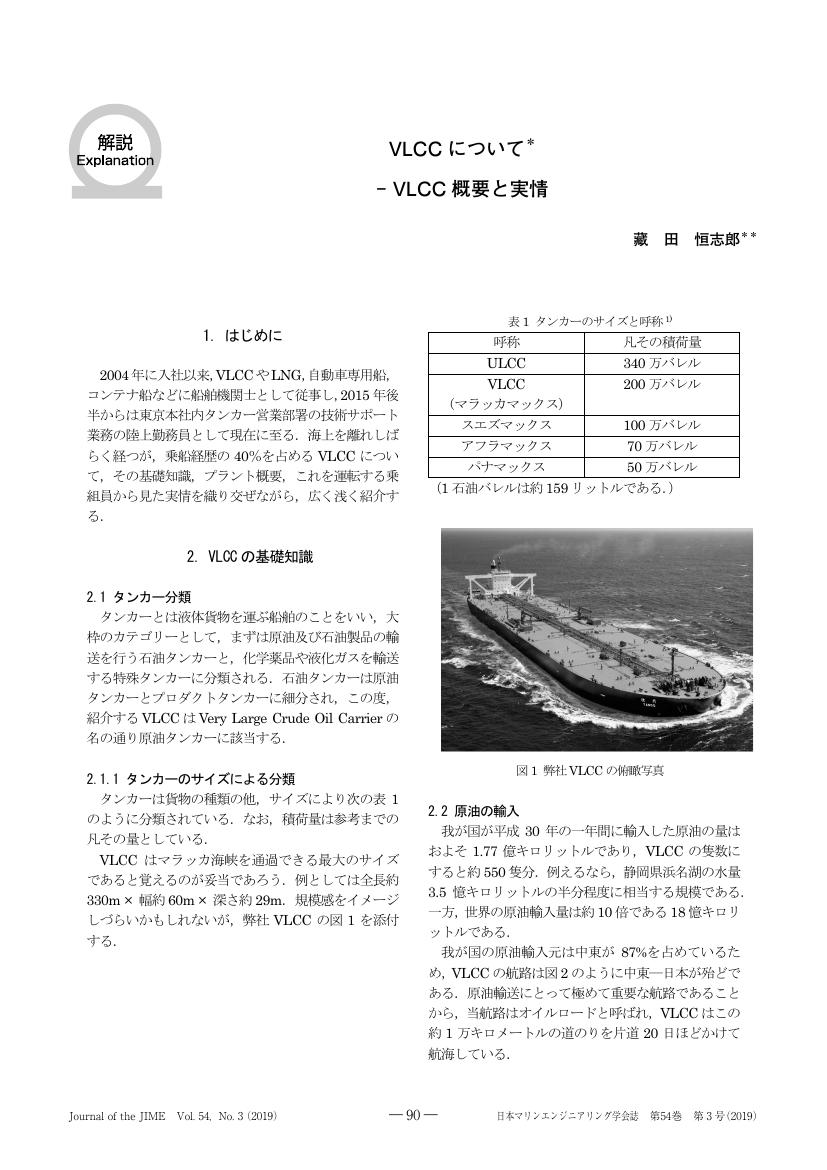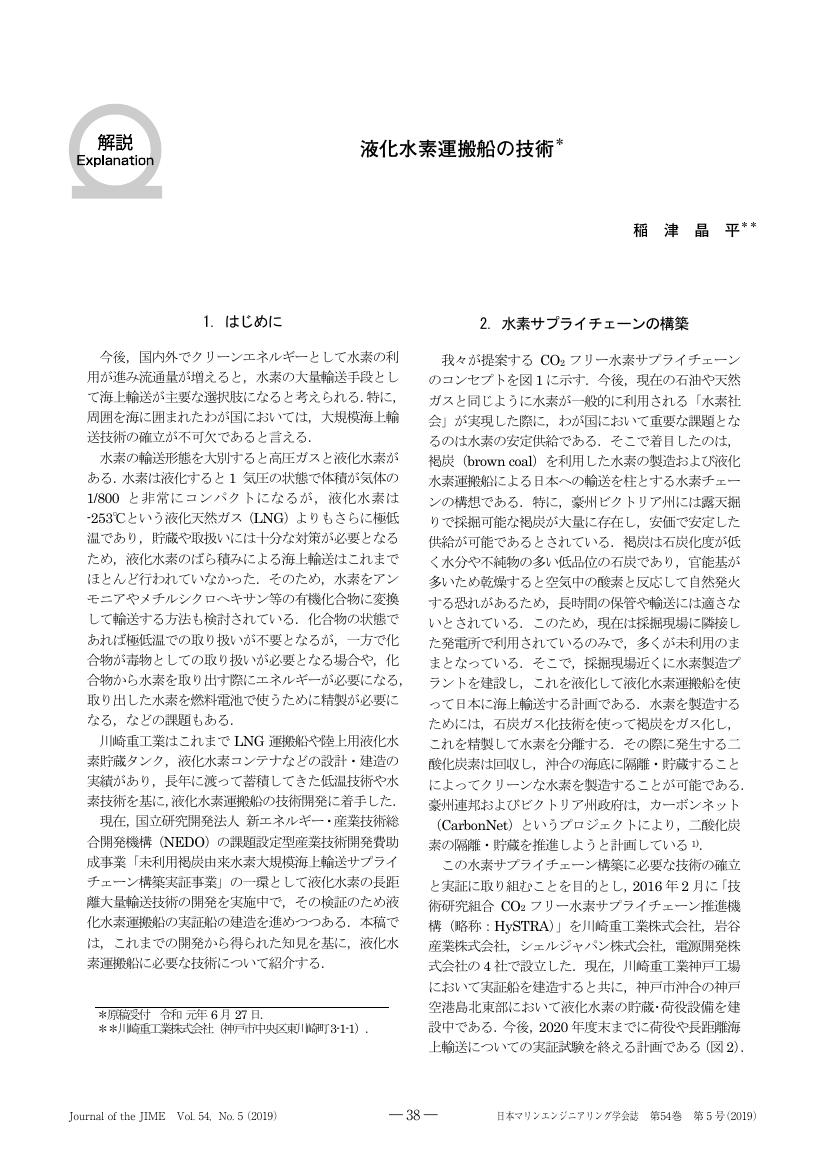1 0 0 0 OA 震災時の東京港における内航貨物船からの陸上電力供給量の推定
- 著者
- 金子 仁 福田 厳 津金 正典 坂本 研也
- 出版者
- 公益社団法人 日本マリンエンジニアリング学会
- 雑誌
- マリンエンジニアリング (ISSN:13461427)
- 巻号頁・発行日
- vol.55, no.1, pp.120-129, 2020-01-01 (Released:2020-01-29)
- 参考文献数
- 6
Japan is a country prone to many natural disasters. There has been a further demand for Japan to improve the reliability of power supply than before the Great East Japan Earthquake. Given the topography of the country, the authors think that the Earthquake taught us how effective ship-to-shore power supply systems are in improving the reliability. This study is to estimate how much power can be supplied from coastal cargo ships moored at Tokyo Port. For calculation purpose, the authors used ship specification data listed in the annual "Register of Ships" published by the Japan Shipping Exchange, Inc. and port mooring facility specification data on the Tokyo Port Facilities List. The result of the calculation showed that 230 moored ships at the port can provide up to 197,000kW, which accounts for 23% of the total amount of power that can be supplied from 2,314 registered coastal cargo ships in Japan.
1 0 0 0 OA 可変ピッチプロペラ装置の油圧について
- 著者
- 藤本 忠浩
- 出版者
- 公益社団法人 日本マリンエンジニアリング学会
- 雑誌
- マリンエンジニアリング (ISSN:13461427)
- 巻号頁・発行日
- vol.54, no.1, pp.65-69, 2019-01-01 (Released:2019-01-31)
1 0 0 0 OA 水素混焼エンジンの現状と課題
- 著者
- 市川 泰久 平田 宏一
- 出版者
- 公益社団法人 日本マリンエンジニアリング学会
- 雑誌
- マリンエンジニアリング (ISSN:13461427)
- 巻号頁・発行日
- vol.54, no.5, pp.694-697, 2019-09-01 (Released:2019-09-21)
- 参考文献数
- 8
1 0 0 0 OA 船舶の冷凍・空調装置用冷媒の変遷と現状・展望
- 著者
- 西藤 浩一
- 出版者
- 公益社団法人 日本マリンエンジニアリング学会
- 雑誌
- マリンエンジニアリング (ISSN:13461427)
- 巻号頁・発行日
- vol.45, no.3, pp.305-309, 2010 (Released:2013-01-26)
- 参考文献数
- 8
1 0 0 0 OA ガスタービンにおける液体アンモニア直接噴霧燃焼技術の研究開発
- 著者
- 内田 正宏 伊藤 慎太朗 須田 俊之
- 出版者
- 公益社団法人 日本マリンエンジニアリング学会
- 雑誌
- マリンエンジニアリング (ISSN:13461427)
- 巻号頁・発行日
- vol.55, no.6, pp.772-776, 2020-11-01 (Released:2020-11-29)
- 参考文献数
- 4
- 被引用文献数
- 1 1
1 0 0 0 液化ジメチルエーテル混合による高粘度難燃性物質の燃焼特性
- 著者
- 三原 悠 浅野 一朗 段 智久 岡村 秀雄 松村 千里 羽賀 雄紀 中坪 良平
- 出版者
- 公益社団法人 日本マリンエンジニアリング学会
- 雑誌
- マリンエンジニアリング (ISSN:13461427)
- 巻号頁・発行日
- vol.56, no.3, pp.473-483, 2021
<p> As a way to improve the combustion characteristics of wood tar which is highly viscous and flame retardant, the authors blended it with liquefied dimethyl ether (DME), which can improve fuel fluidity, ignitability and spray atomization. Moreover, heavy fuel oil (bunker-c oil) was added to increase the heating value of this fuel sample. The sample, which has the blending ratio of 35 % wood tar, 30% DME and 35% bunker-c by weight, was used in a combustion test with a three-cylinder in-direct injection diesel engine. Additionally, the authors also investigated particulate matter (PM) produced after burning four samples that mixed liquefied DME with flame retardant fuels in the same engine to analyze its environmental and biological impacts. The four samples prepared for the experiment were (1) 70% distillate oil (bunker-a) and 30% DME; (2) 85% bunker-c and 15% DME; (3) 70% bunker-c and 30% DME; (4) 35 % bunker-c, 30% DME and 35% wood tar.</p><p> The results of the engine test suggested the possibility that wood tar could become more combustible by optimizing the flow rate of fuel and the blend ratio of liquefied DME and bunker-c. In the (4) case, PM showed no high mutagenic potentials and there were lower concentrations of such inorganic substances as vanadium and nickel. Polycyclic aromatic hydrocarbons (PAHs) concentrations in PM decreased by blending liquefied DME with bunker-c, whereas did not decrease for the wood tar.</p>
1 0 0 0 OA VLCCについて - VLCC概要と実情
- 著者
- 藏田 恒志郎
- 出版者
- 公益社団法人 日本マリンエンジニアリング学会
- 雑誌
- マリンエンジニアリング (ISSN:13461427)
- 巻号頁・発行日
- vol.54, no.3, pp.406-412, 2019-05-01 (Released:2019-05-30)
- 参考文献数
- 4
1 0 0 0 OA エネルギー効率設計指標(EEDI)規制と対応技術動向
- 著者
- 荒木 康伸
- 出版者
- 公益社団法人 日本マリンエンジニアリング学会
- 雑誌
- マリンエンジニアリング (ISSN:13461427)
- 巻号頁・発行日
- vol.52, no.4, pp.480-484, 2017-07-01 (Released:2018-03-07)
- 参考文献数
- 1
- 被引用文献数
- 1
1 0 0 0 OA 潮流・海流発電について
- 著者
- 平木 講儒
- 出版者
- 公益社団法人 日本マリンエンジニアリング学会
- 雑誌
- マリンエンジニアリング (ISSN:13461427)
- 巻号頁・発行日
- vol.50, no.1, pp.36-41, 2015-01-01 (Released:2016-01-27)
- 参考文献数
- 3
1 0 0 0 OA 液化水素運搬船の技術
- 著者
- 稲津 晶平
- 出版者
- 公益社団法人 日本マリンエンジニアリング学会
- 雑誌
- マリンエンジニアリング (ISSN:13461427)
- 巻号頁・発行日
- vol.54, no.5, pp.704-708, 2019-09-01 (Released:2019-09-21)
- 参考文献数
- 4
1 0 0 0 OA “さんふらわあ さっぽろ”大震災,港外退避とその後の緊急輸送等について
- 著者
- 加藤 勝則
- 出版者
- 公益社団法人 日本マリンエンジニアリング学会
- 雑誌
- マリンエンジニアリング (ISSN:13461427)
- 巻号頁・発行日
- vol.47, no.2, pp.165-170, 2012-03-01 (Released:2013-10-30)
1 0 0 0 OA 渋谷文庫成立の由来とその意義
- 著者
- 石谷 清幹
- 出版者
- 公益社団法人 日本マリンエンジニアリング学会
- 雑誌
- マリンエンジニアリング (ISSN:13461427)
- 巻号頁・発行日
- vol.41, no.1, pp.58-61, 2006-01-01 (Released:2010-05-31)
1 0 0 0 OA 新形式スーパーエコシップ(SES)の開発-2軸型 SES の開発の状況と今後の展望
- 著者
- 加戸 正治
- 出版者
- 公益社団法人 日本マリンエンジニアリング学会
- 雑誌
- マリンエンジニアリング (ISSN:13461427)
- 巻号頁・発行日
- vol.46, no.3, pp.392-399, 2011 (Released:2013-10-23)
- 参考文献数
- 11
Japan Railway Construction, Transport and Technology Agency (JRTT) has developed three types of SES for domestic coastal ships and promoted their wide use under the support of the Ministry of Land, Infrastructure, Transport and Tourism. These three types of SES, the Line Shaft CRP type, the Tandem Hybrid type and the Twin POD type were developed in cooperation with shipbuilding companies and marine equipment manufacturing companies. In total, 17 SES type ships have been delivered and currently three more SES ships are under construction. JRTT, research organizations and engineering and manufacturing companies are now jointly promoting the development project of Twin-propeller type SES as a new type of SES in addition to the three existing SES. Twin-propeller type SES is expected to give higher performance and lower building costs in comparison with the other SES and all other similar type of ships.
1 0 0 0 OA 作業船の概要及び紹介
- 著者
- 皿澤 薫
- 出版者
- 公益社団法人 日本マリンエンジニアリング学会
- 雑誌
- マリンエンジニアリング (ISSN:13461427)
- 巻号頁・発行日
- vol.53, no.6, pp.826-833, 2018-11-01 (Released:2018-11-17)
- 参考文献数
- 2
1 0 0 0 OA TBTポリマーに替わる新しい防汚塗料用樹脂
- 著者
- 山盛 直樹
- 出版者
- 公益社団法人 日本マリンエンジニアリング学会
- 雑誌
- マリンエンジニアリング (ISSN:13461427)
- 巻号頁・発行日
- vol.40, no.1, pp.20-22, 2005-01-01 (Released:2010-05-31)
- 参考文献数
- 3
- 著者
- 井手 雅夫
- 出版者
- 公益社団法人 日本マリンエンジニアリング学会
- 雑誌
- マリンエンジニアリング (ISSN:13461427)
- 巻号頁・発行日
- vol.52, no.5, pp.610-617, 2017
1 0 0 0 「舶用電気設備の技術動向」特集号によせて
- 著者
- 雨宮 徳一
- 出版者
- 公益社団法人 日本マリンエンジニアリング学会
- 雑誌
- マリンエンジニアリング (ISSN:13461427)
- 巻号頁・発行日
- vol.48, no.5, pp.587, 2013
- 著者
- 長屋 茂樹
- 出版者
- 公益社団法人 日本マリンエンジニアリング学会
- 雑誌
- マリンエンジニアリング (ISSN:13461427)
- 巻号頁・発行日
- vol.54, no.2, pp.283-286, 2019-03-01 (Released:2019-03-29)
- 参考文献数
- 2
1 0 0 0 OA 微粒子ピーニングによる表面改質手法 - 生産性を考慮した複合表面改質技術の提案
- 著者
- 宇佐美 初彦
- 出版者
- 公益社団法人 日本マリンエンジニアリング学会
- 雑誌
- マリンエンジニアリング (ISSN:13461427)
- 巻号頁・発行日
- vol.55, no.1, pp.28-33, 2020-01-01 (Released:2020-01-29)
- 参考文献数
- 21
1 0 0 0 OA 海洋掘削のためのライザー管について
- 著者
- 小川 和彦
- 出版者
- 公益社団法人 日本マリンエンジニアリング学会
- 雑誌
- マリンエンジニアリング (ISSN:13461427)
- 巻号頁・発行日
- vol.50, no.5, pp.688, 2015-09-01 (Released:2016-12-03)
- 参考文献数
- 2














